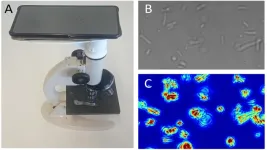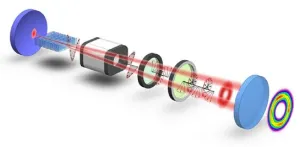(Press-News.org) Scientists observed seismic waves traveling through Mars’ core for the first time and confirmed model predictions of the core’s composition.
An international research team—which included University of Maryland seismologists—used seismic data acquired by the NASA InSight lander to directly measure properties of Mars’s core, finding a completely liquid iron-alloy core with high percentages of sulfur and oxygen. Published in the Proceedings of the National Academy of Sciences on April 24, 2023, these findings reveal new insights into how Mars formed and geological differences between Earth and Mars that may ultimately play a role in sustaining planetary habitability.
“In 1906, scientists first discovered the Earth’s core by observing how seismic waves from earthquakes were affected by traveling through it,” said UMD Associate Professor of Geology Vedran Lekic, second author of the paper. “More than a hundred years later, we’re applying our knowledge of seismic waves to Mars. With InSight, we’re finally discovering what’s at the center of Mars and what makes Mars so similar yet distinct from Earth.”
To determine these differences, the team tracked the progression of two distant seismic events on Mars, one caused by a marsquake and the other by a large impact, and detected waves that traveled through the planet’s core. By comparing the time it took those waves to travel through Mars compared to waves that stayed in the mantle, and combining this information with other seismic and geophysical measurements, the team estimated the density and compressibility of the material the waves traveled through. The researchers’ results indicated that Mars most likely has a completely liquid core, unlike Earth’s combination of a liquid outer core and solid inner core.
Additionally, the team inferred details about the core’s chemical composition, such as the surprisingly large amount of light elements (elements with low atomic numbers)—namely sulfur and oxygen—present in Mars’ innermost layer. The team’s findings suggested that a fifth of the core’s weight is made up of those elements. This high percentage differs sharply from the comparatively lesser weight proportion of light elements in Earth’s core, indicating that Mars’ core is far less dense and more compressible than Earth’s core, a difference that points to different conditions of formation for the two planets.
“You can think of it this way; the properties of a planet’s core can serve as a summary about how the planet formed and how it evolved dynamically over time. The end result of the formation and evolution processes can be either the generation or absence of life-sustaining conditions,” explained UMD Associate Professor of Geology Nicholas Schmerr, another co-author of the paper. “The uniqueness of Earth’s core allows it to generate a magnetic field that protects us from solar winds, allowing us to keep water. Mars’ core does not generate this protective shield, and so the planet’s surface conditions are hostile to life.”
Although Mars does not currently have a magnetic field, scientists hypothesize that there was once a magnetic shielding similar to Earth’s core-generated field due to traces of magnetism lingering in Mars’ crust. Lekic and Schmerr noted that this might mean that Mars gradually evolved to its current conditions, changing from a planet with a potentially habitable environment into an incredibly hostile one. Conditions in the interior play a key role in this evolution, as might violent impacts, according to the researchers.
“It’s like a puzzle in some ways,” Lekic said. “For example, there are small traces of hydrogen in Mars’ core. That means that there had to be certain conditions that allowed the hydrogen to be there, and we have to understand those conditions in order to understand how Mars evolved into the planet it is today.”
The team’s findings have ultimately confirmed the accuracy of current modeling estimates that aim to unravel the layers hidden beneath a planet’s surface. For geophysicists like Lekic and Schmerr, research like this is also paving the way for future geophysics-oriented expeditions to other celestial bodies, including planets like Venus and Mercury.
“This was a huge effort, involving state-of-the-art seismological techniques which have been honed on Earth, in conjunction with new results from mineral physicists and the insights from team members who simulate how planetary interiors change over time,” noted Jessica Irving, a senior lecturer at Bristol University and first author of the study. “But the work paid off, and we now know much more about what’s happening inside the Martian core.”
“Even though the InSight mission ended in December 2022 after four years of seismic monitoring, we're still analyzing the data that was collected,” Lekic said. “InSight will continue to influence how we understand the formation and evolution of Mars and other planets for years to come.”
###
The paper, “First observations of core-transiting seismic phases on Mars,” was published in the Proceedings of the National Academy of Sciences on April 24, 2023.
This research was supported by NASA (Grant Nos. 80NSSC18K1628 and 80NSSC19M0216) and the SSERVI Cooperative Agreement. This story does not necessarily reflect the views of these organizations.
END
A new study has uncovered intriguing insights into the liquid core at the centre of Mars, furthering understanding of the planet’s formation and evolution.
The research, led by the University of Bristol and published in the journal Proceedings of the National Academy of Sciences of the US, reveals the first-ever detections of sound waves travelling into the Martian core. Measurements from this acoustic energy, called seismic waves, indicate its liquid core is slightly denser and smaller than previously thought, and comprises a mixture of iron and numerous other elements.
The ...
“We have developed a technique in our laboratories that allows us to obtain an antibiogram within 2-4 hours – instead of the current 24 hours for the most common germs and one month for tuberculosis,” says Dr Sandor Kasas at EPFL. Professor Ronnie Willaert at Vrije Universiteit Brussel adds: “Our technique is not only faster but also simpler and much cheaper than all those existing now.”
Antibiotic resistance happens when bacteria develop the ability to defeat the drugs designed to kill them. It ...
Targeting part of an antiviral pathway triggered by the accumulation of a key pathogen shared in Alzheimer’s disease and frontotemporal dementia may one day offer a new therapeutic approach to deterring or delaying cognitive decline, according to preclinical research led by Weill Cornell Medicine scientists.
The study, published April 24 in Nature Neuroscience, demonstrates that inhibiting an innate immune system enzyme called cyclic GMP–AMP synthase (cGAS) helps neurons become resilient to the build-up of the protein tau into bundles known as fibrils, a hallmark of Alzheimer’s and some forms of frontotemporal dementia, the two most ...
Organic solar cells have a photoactive layer that is made from polymers and small molecules. The cells are very thin, can be flexible, and are easy to make. However, the efficiency of these cells is still much below that of conventional silicon-based ones. Applied physicists from the University of Groningen have now fabricated an organic solar cell with an efficiency of over 17 percent, which is in the top range for this type of material. It has the advantage of using an unusual device structure that is produced using a scalable technique. The design involves a conductive layer of tin oxide that is grown ...
The 25th International Conference on Redox Medicine will take place on June 21-23 in Paris. Redox Medicine 2023 will provide a glimpse into the role of redox in tomorrow’s medicine.
What to Expect in Redox Medicine 2023?
Reactive oxygen species (ROS) have been studied for decades, but the results remain controversial. ROS are beneficial to biological mechanisms, acting as signaling molecules and enhancing immune defense. However, they also have harmful effects, such as causing tissue and organ damage.
Dr. Carole Nicco, stated that “The work and results presented at the Redox Medicine Congress will give ...
Key takeaways
A study by researchers from UCLA, Australia, Ecuador, Germany, the Netherlands and the U.K. found that people around the world signal others for assistance every couple of minutes.
The research, which examined behaviors in towns and rural areas in several different countries, revealed that people comply with these small requests for help far more often than they decline them.
The findings suggest that people from all cultures have more similar cooperative behaviors than prior research has established.
A new study by UCLA sociologist Giovanni Rossi and an international team of collaborators finds that people rely on ...
WASHINGTON, DC – The Department of Energy’s (DOE’s) Office of Science will sponsor the participation of 999 undergraduate students and 79 faculty members in three STEM-focused workforce development programs at 16 DOE national laboratories and a national fusion facility during summer 2023. Collectively, these programs ensure DOE and our nation have a strong, sustained workforce trained in the skills needed to address the energy, environment, and national security challenges of today and tomorrow.
“Our future depends on the next generation ...
“One of the great mysteries of biology,” says Eric Libby, former SFI Postdoctoral Fellow, now an associate professor at the Integrated Science Lab (IceLab), Umeå University in Sweden, “is eukaryogenesis, or how eukaryotes arose.” Scientists consider this to be a period of major evolutionary transition, critical to our understanding of the history and evolution of life on Earth.
In a new study published on April 21, 2023, in PNAS, Libby worked with SFI Professor Christopher Kempes and Jordan ...
The U.S. Department of Energy’s (DOE) Argonne National Laboratory has awarded its newest cohort of named fellowships, providing five early-career scientists with additional support as they pursue pivotal discoveries that will make Americans safer and better off and increase our understanding of the universe.
For 2023, the laboratory has named four Maria Goeppert Mayer Fellows and one Walter Massey Fellow. Maria Goeppert Mayer was a pioneering nuclear physicist who received the 1963 Nobel Prize in physics for discovering, at Argonne, the shell model of the atomic nucleus. Walter Massey ...
Laguerre-Gaussian (LG) modes are a type of light wave that can carry the external torque of photons as they move through space. They are useful in many fields, from optical communications to super-resolution imaging. Advanced developments in these and other applications demand reliable and color-tunable LG mode laser sources, which do not yet exist.
An optical parametric oscillator (OPO) is a device that can generate a wavelength-tunable laser beam, so it has been used to realize a color-tunable LG laser source — generally, in one of two ways. One way is to change a regular beam into an LG beam using a phase component ...







